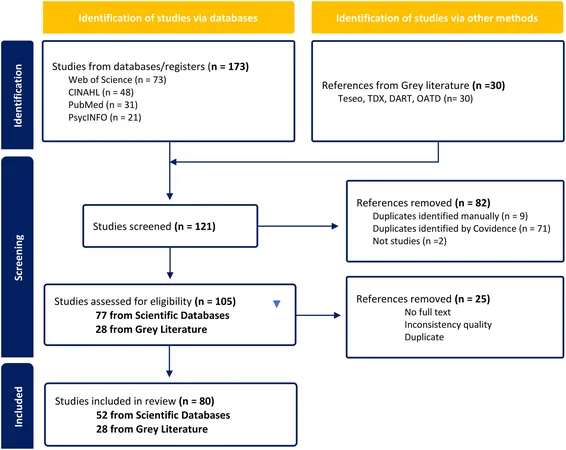
Loneliness in Aging Populations: The Hidden Crisis We Can't Ignore
2025-04-10
Author: Daniel
The Rising Tide of Loneliness Among Older Adults
As Europe faces an unprecedented demographic shift, millions of older adults are grappling with the shadows of social isolation and loneliness. Almost 20% of individuals aged 65 and above in the European Union live alone, a staggering statistic that reflects the deeper societal changes brought on by declining birth rates, longer life expectancies, and the breakdown of traditional family structures. A shocking survey from Age UK revealed that approximately 1.2 million seniors in the UK are chronically lonely, a reality likely echoed across other nations. The increasing prevalence of solitude isn’t just numbers—it’s a loud wake-up call.
Understanding Loneliness: More Than Just Being Alone
Often confused as the same issue, social isolation and loneliness are distinctly different. Social isolation refers to the measurable absence of social interactions, while loneliness is a subjective emotional experience stemming from unfulfilled social needs. Notably, one can be socially isolated yet not feel lonely, and vice versa. This nuanced difference highlights the urgent need for tailored assessment and intervention strategies. Recent surveys show that loneliness affects between 30% to 55% of older adults in Central and Eastern Europe, as opposed to just 10% to 20% in Northwestern Europe.
The Health Consequences of Loneliness: A Silent Epidemic
Loneliness is not just an emotional burden; it's a ticking time bomb that significantly impacts physical and mental health. The transition into old age can foster feelings of isolation through various life changes—loss of loved ones, health declines, or mobility issues—which can heighten the vulnerability to loneliness. This pervasive sense of isolation is closely linked to severe mental health struggles, increased risk of depression, anxiety, and even suicidal thoughts, particularly when loneliness feels enduring and unwanted.
Community-Dwelling and Social Isolation: A Critical Look
Research reveals that community-dwelling seniors—those living independently at home—are at heightened risk for social isolation due to age-related mobility declines and vanishing social networks. This demographic deserves urgent attention and understanding, especially given that an estimated 20% to 30% of them suffer from significant social isolation. A comprehensive exploration of the landscape of loneliness among this group is imperative to identify key factors, impactful consequences, and research gaps.
Mapping the Frontier of Research: A Scoping Review
In an effort to understand this pressing issue, a scoping review was conducted, charting the landscape of research on loneliness among older adults living independently. This review highlighted the need for a deeper exploration of factors and consequences related to loneliness. Through a meticulous framework guiding the research process, the review sought to identify the principal questions that will steer future inquiries.
Shocking Findings: The Hidden Dimensions of Loneliness
The review unearthed striking evidence: loneliness is intricately associated with various negative health outcomes. From cardiovascular disease to cognitive decline, the implications are dire. Community-based studies shed light on how loneliness and isolation affect physical health, with many older adults experiencing profound impacts. These findings advocate for urgent community engagement and public health initiatives to tackle loneliness.
The Role of Gender and Health in Loneliness
Gender dynamics play a crucial role in understanding loneliness. Research indicates that women may experience higher levels of depression and anxiety related to loneliness, while men face unique challenges related to loss in social networks post-retirement. These gender-specific insights can inform targeted strategies to combat loneliness effectively.
Path Forward: The Need for Comprehensive Interventions
To combat the lurking specter of loneliness, a multifaceted approach is necessary. Public health policies amplifying social engagement, along with targeted interventions for vulnerable populations, are essential. With the increasing integration of digital solutions, understanding their role in mitigating emotional loneliness is critical. The research landscape is ripe for further exploration, demanding longitudinal designs and inclusive studies that reflect the complexities of loneliness.
Conclusion: A Call to Action
Loneliness among older adults is an urgent public health crisis that demands our attention. By embracing an integrative perspective that considers individual, environmental, and socioeconomic factors, we can effectively tackle this multifaceted phenomenon. As our global population continues to age, combating loneliness must remain a priority within our public health and policy frameworks—after all, no one should have to face the twilight years alone.


 Brasil (PT)
Brasil (PT)
 Canada (EN)
Canada (EN)
 Chile (ES)
Chile (ES)
 Česko (CS)
Česko (CS)
 대한민국 (KO)
대한민국 (KO)
 España (ES)
España (ES)
 France (FR)
France (FR)
 Hong Kong (EN)
Hong Kong (EN)
 Italia (IT)
Italia (IT)
 日本 (JA)
日本 (JA)
 Magyarország (HU)
Magyarország (HU)
 Norge (NO)
Norge (NO)
 Polska (PL)
Polska (PL)
 Schweiz (DE)
Schweiz (DE)
 Singapore (EN)
Singapore (EN)
 Sverige (SV)
Sverige (SV)
 Suomi (FI)
Suomi (FI)
 Türkiye (TR)
Türkiye (TR)
 الإمارات العربية المتحدة (AR)
الإمارات العربية المتحدة (AR)